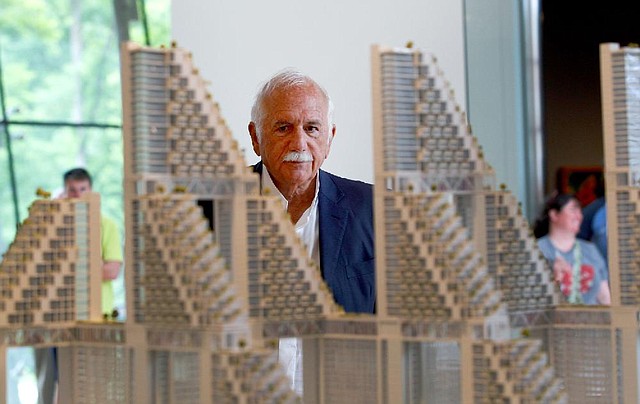His works on display, Crystal Bridges architect pays a visit
Architect Moshe Safdie stands behind a model, Urban Window Habitat, on Wednesday during a tour of the “Global Citizen:The Architecture of Moshe Safdie” exhibit at the Crystal Bridges Museum of American Art in Bentonville. The temporary exhibit is on display through Sept. 1.
Thursday, June 26, 2014
BENTONVILLE -- Architect and urban planner Moshe Safdie is accustomed to competing for business. For more than four decades, Safdie has competed for projects including cultural and civic institutions, mixed-use urban centers and airports all around the world.
But the world-renowned architect didn't have to compete for the job of designing Crystal Bridges Museum of American Art.
Museum founder Alice Walton was familiar with Safdie's work on the Skirball Cultural Center in Los Angeles and Peabody Essex Museum in Salem, Mass., when she invited Safdie to meet her in Northwest Arkansas.
He said she drove him to her log cabin and cooked him a steak as they embarked on discussions about what would eventually become Crystal Bridges. The next day they walked four to five possible sites that Walton had picked for the museum, and about the time he boarded a plane to leave, he asked her what her process would be for selecting an architect.
"She said, 'Well, I've been looking at people's work for the past two years, and tonight is the end of my search,'" Safdie said. "It was a very moving way to be picked to do the work."
Safdie, 75, was at the Bentonville museum Wednesday to talk with the media about "Global Citizen: The Architecture of Moshe Safdie," a temporary exhibit that is a retrospective of his work from as far back as his 1967 Habitat, a first-of-its kind housing complex in Montreal.
His newer projects in the exhibition include structures known as Global Centers, including Khalsa Heritage Centre in Anandpur Sahib, India, and Palm Jumeirah Gateway Mosque in Dubai. Other displays feature variations on Habitat, his North American works and his many projects in his native Israel, including the Yad Vashem Holocaust Museum in Jerusalem and Ben Gurion Airport in Tel Aviv.
A walking tour led by Safdie for representatives of the media weaved through the museum's permanent collection galleries, the lower lobby, the south lobby, the Great Hall and last to the museum's library. Some 30 projects in the exhibition are represented throughout the museum in the form of 200 or so sketches, photographs, video pieces, models and other materials that led to Safdie's projects.
The exhibition, conceived and created by Donald Albrecht, curator of architecture and design at the Museum of the City of New York, also offers Safdie's philosophies behind the projects represented. It's Safdie's belief that a building should be an extension of its physical, historical and cultural environments.
The works in the retrospective have been on public view in its current format only at Skirball, from the fall of 2013 to spring of this year. At Crystal Bridges, the exhibition is open and free to the public through Sept. 1. At this time, there are no plans for the exhibition to be displayed elsewhere, said Diane Carroll, the museum's director of communications.
The 200,000-square-foot museum sits at the base of a ravine with water flowing under and around its eight pavilions. The contours of the buildings and bridges were intentionally created to mimic the surrounding landscape. It was a conscious decision to keep the greater part of the museum hidden from view until visitors arrive at the entrance, Safdie said Wednesday.
Nearly three years since Crystal Bridges opened, Safdie gazed with a critical eye as he walked the museum's galleries, bridges and other areas.
He is particularly proud of the intentional visible changes that have occurred over time to the building's exterior, which consists of contoured cement walls accented with cedar banding and copper roofs. In the art gallery focused on the 20th century, he acknowledged the decision to use curved walls. Even with monumental-size artwork on display, "it works," he said.
Safdie said Wednesday that he's surprised that the museum is so busy. While he was walking and talking, many visitors dropped in and out of the tour, some of whom acknowledged his celebrity. He recalled that when the museum opened Nov. 11, 2011, it was embraced by people across the area.
"It had something to do with what it did for Bentonville and the region," he said. "The people were so happy to receive this, so grateful and appreciative.
"It's a building about joy and cheerfulness. There's very little that oppresses you or sort of intimidates you," he added.
Metro on 06/26/2014
